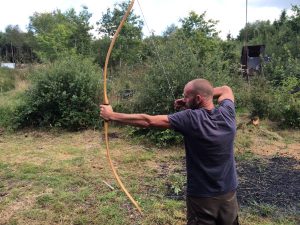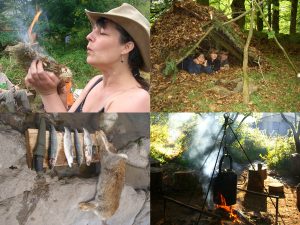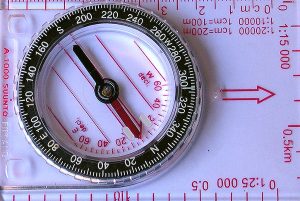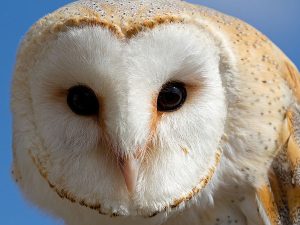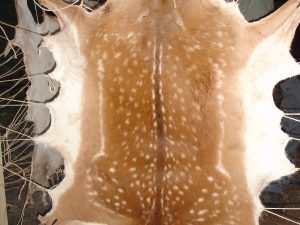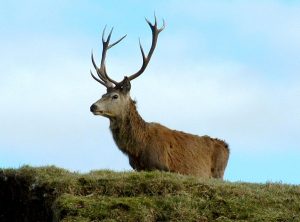Tracking - introduction
“To really learn tracking at the deepest level, we need to have a complete understanding of how nature works as a system that includes plants, trees, birds, frogs, insects & energy cycles through time & space.” – Brian Mertins
Contents
What is tracking?
Tracking is the art and science of detecting, identifying and following signs left by animals. A ‘sign’ is anything that indicates that an animal is or has been in the area, or tells you about its behaviour. Some examples of signs (or ‘spoors’) are: tracks (footprints); trails or runs (pathways made by animals); scat (poo) or urine; beds (resting or sleeping places); calls or cries; burrows or dens (living or breeding areas); rubs (fur, hair or feathers left by intentional or accidental rubbing against objects such as trees); shed skins; evidence of feeding; and scratches or bite marks on trees or vegetation, among many others. The animal being tracked is sometimes referred to as the ‘quarry’, particularly when hunted. Expert trackers are able to ‘read’ the ground in front of them like a newspaper – to identify a specific animal, get information about its activities, hypothesise about its movements and follow its trail for several days – all from the signs it leaves behind. Tracking is used in hunting, conservation or research – or simply for the sheer pleasure of finding and observing animals in their natural habitat.

An animal’s tracks are one of the most useful signs when attempting to identify it and follow its trail. Like human fingerprints, every animal – from insects to elephants – has a unique footprint that can be used to determine its species (whether it’s a hoof, paw or claw, how big it is, what shape, how many toes, claws etc.), the direction, speed and purpose of travel (whether fleeing a predator or stalking prey), how it moves (gait), when it passed through (by how fresh or degraded the track is), and sometimes even its sex or state of health (abnormal gait may indicate an injury, for example). The size of the tracks can also indicate whether it’s very young or fully grown and smaller tracks alongside larger ones may mean a female with young. Trackers primarily follow these footprints, scanning for other signs along the way to confirm their impressions (scat, evidence of feeding, broken or bruised vegetation caused by the animal pushing through, whether the bruising is still fresh and wet or older and scarred, etc.). Experienced trackers can also tell the difference between paths made and used by a number of animals (the superhighways of the forest) and species-specific runs used for feeding, watering or breeding. Runs are particularly useful to hunters as you know which animal you are likely to encounter. How easy the trail is to follow depends to a large extent on the ground: any natural surface responds to any animal’s footfall, but surfaces like soft mud or sand hold tracks really well, whereas hard ground or leaf litter are much more difficult to read.

Whilst perhaps less appealing, scat is a (black) gold mine of information, as are urine deposits. The droppings of different species vary greatly in size, shape, composition and quantity. The freshness of scat also tells you when the animal was there and holds a wealth of information on health, diet (carnivore or herbivore, for example), seasonal variations and whether food is plentiful or scarce at that time (i.e. whether a predator has eaten every morsel of a kill or not). Knowing what’s on the menu can also help you work out where the animal is likely to be – e.g. bits of undigested apple mean you should probably look for it close to apple trees. Scat and urine deposits are a key form of communication for many animals that have scent glands in their anus and use strategically placed droppings to communicate important matters such as territorial boundaries or availability for mating. While these ‘bulletin boards’ are normally intended for members of the same species, it’s thought other animals may also take advantage of them. For example, an animal may be able to tell what its predator is up to from smelling its scat or urine.
History
Humans have been tracking since prehistoric times. For early hunter-gatherer societies, the ability to find food or detect threats to the community literally meant the difference between life and death, and the development of tracking skills would have increased the chances of a successful hunt. Tracking was necessary not just to find the quarry in the first place, but also to follow the trail of a wounded animal if it wasn’t immediately killed. Over the intervening millennia, tracking skills have gradually been lost by most cultures as tools and technology have allowed us to evolve past subsistence living, culminating in the near-total disconnection from our food sources experienced by many in the developed world today. While many cultures still practice different forms of hunting, technologies such as telescopic rifle scopes have removed the need to get close to the quarry, and today only very few indigenous cultures still use tracking for survival.

What are the benefits of tracking?
Self-provisioning / personal
Along with other bushcraft skills, the ability to track and hunt provides you with the means to survive from the land. Gaining any skills around harvesting food from the wild can help meet your you and your family’s needs (especially in times of food shortages) for free, in a way that can bring a lot of satisfaction. Tracking piques an ancient interest and primal connection to the Earth and to our ancestors; we’re here today largely because of their ability to use these same skills.
Apart from connecting us to our past, being able to interpret signs and follow a trail is hugely enjoyable and it’s really gratifying to see an animal in the wild that you would have missed without tracking skills. Being able to ‘read’ nature fills in the blanks in our understanding of our environment and gives us an increased appreciation of and connection to it.
Like any outdoor pursuit, tracking is great for getting you up and moving and keeping you in shape. It teaches you discipline and patience and provides great mental stimulation. Humans are puzzle-solvers by nature and few riddles are more enjoyable than trying to decipher the ground in front of you and delve into the recent past to figure out what an animal has been up to.
Decentralising power away from corporations
Providing things for ourselves helps prevent extraction, which decentralises power away from corporations (which makes it more difficult for them to corrupt democracy). With tracking skills for hunting, we can help provide ourselves and our communities with wild meat, without having to give money to corporate supermarkets.

Building community and preparing for any potential collapse scenarios
In case of any kind of collapse scenario (broken supply chains, environmental destruction, financial crash, war, civil unrest etc.), we’re going to have to look after ourselves in our communities, and so the more people with useful skills the better. If broken supply chains mean food shortages, the ability to track and hunt wild game such as deer, rabbits, pigeons etc. might mean the difference between life and death.
Environmental
Understanding animals can help conquer the innate fear and ignorance that sometimes leads to them being needlessly killed, harmed or otherwise interfered with. Tracking is an important part of sustainable hunting practices, not only to find the animal in the first place, but also to follow it and finish it off if wounded. and is potentially lower impact than other methods of hunting such as baiting (since artificially providing a source of food alters the behaviour of other animals in the vicinity).
Tracking can also be useful in conservation or research. Data on animal behaviour and migrations provided by GPS collars or direct observation are a vital part of ecology and climate change studies. However, fitting a collar usually involves trapping and/or tranquilising the animal, which can cause stress, while direct observation runs the risk of detection and/or influencing the animal’s behaviour. Tracking can complement these methods, providing valuable information without the need to actually come into contact with the animal. Trackers can even employ their skills to detect that most dangerous of human animals, the poacher.

What can I do?
To be a good tracker you need patience, determination, perseverance, keen observation skills and the ability to stay still and quiet, to keep motivated when the trail gets hard to follow and, most importantly, to keep an open mind and be able to put yourself in the animal’s position to extrapolate about its activity and intentions. You need to develop a heightened “540° awareness” of what’s going on around you (i.e. all around and up above; some animals like to get up trees). Trackers also need to cultivate an encyclopaedic knowledge of animal species and behaviours, the sounds they make and the environments they live in, including types of vegetation and seasonal changes.
There are books and websites you can use to start learning to identify tracks and other signs (see further resources). However, there are many subtle differences between animals, so to really progress you need to take a practical class or course led by an experienced tracker who can take you out in the field.
You don’t need any specialist equipment for tracking but the following are useful: binoculars to observe animals from a distance; camera to photograph them or to record tracks and build up your own references; tape measure for sizing tracks; magnifying glass for discerning minute details; and a torch. As we are visual animals, much of our tracking ability relies on light, so even in the daytime a torch can be useful in low light to throw a track into relief and make it easier to read.

Once you’ve picked up some basic skills you can practice them anywhere, from the forest to your local park, or even in your back garden. Animals are everywhere and they all leave signs if you know what you’re looking for. Think about what kind of animals might live in the area you’re in and what signs they might leave. Bear in mind though that ground varies greatly in terms of ‘readability’, so start off by looking for ‘track traps’ – areas of soft ground that easily take and retain a footprint, such as snow, mud or sand. Winter or autumn are therefore good times to learn as the ground is likely to be softer after rain. Tracking can be extremely difficult and frustrating at first and takes a long time to master, so actually spotting a few things will help keep you motivated.
Remember that most animals have senses of hearing and smell far superior to our own and are easily startled, so it’s important to keep quiet. Close your car door quietly, keep your voice down and your phone on silent. Pick your feet up carefully and avoid stepping on noisy surfaces like dead leaves or dry grass. Tracking enables you to come into animals’ lives and homes and this power shouldn’t be taken lightly. Whether you’re hunting for food or just observing, it’s vital to respect both your quarry and other animals by being as non-intrusive as possible. Getting too close or damaging foraging areas can cause serious distress and disturb behaviour, potentially leading to abandoning young or territory, interrupting breeding or even death. If you do come upon an animal unexpectedly, try to stay downwind of it, move slowly and carefully to avoid disturbing it further and under no circumstances damage its den or other areas it may be using.

Tracking isn’t a particularly dangerous activity in the UK, which has few large predators or poisonous animals. However, it’s still important to be aware of what can harm you in nature (stinging plants or insects, or snakes like adders, for example). Some trackers recommend not handling scat with your bare hands, though its contents do yield a lot of information (definitely wash your hands well before handling food either way). As with any outdoor activity, a little common sense goes a long way: take plenty of food, water, a map or GPS, appropriate clothing and footwear, check the weather forecast, keep your phone fully charged and let someone know where you’re going and when you expect to be back.
Further resources
- the Stalking Directory – huge forum about deer stalking
- Wildlife Tracking Skills (pdf) – how an animals tracks change depending on how / how fast they’re moving
Specialist(s)
Thanks to Rob Speiden from the Natural Awareness Tracking School.
The specialist(s) below will respond to queries on this topic. Please comment in the box at the bottom of the page.

John Rhyder is a naturalist, woodsman and certified wildlife tracker, he is both founder and head Instructor at Woodcraft School. He is a gifted naturalist and is certified through CyberTracker wildlife tracking accreditation as a track and sign specialist having scored 100% on a specialist evaluation. This makes John the first, and currently, the only level 4 and therefore the highest qualifed wildlife tracker in Northern Europe.

